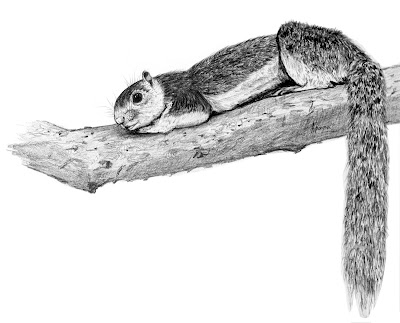 |
Pencil drawing of a rusty-spotted cat at strolling at nighttime by Aparna K.
|
I have loved cats all my life. My fascination with cats started when I rescued my very first cat. Growing up in a small town allowed me to scamper around all day long without any adult supervision. This also meant that a boy in my street used this unsupervised time one day to torment a poor little kitten. This kitten and a pup that seemed quiet ferocious were tied together by a rope attached to a pole. The frightened kitten ran in circles, chased hot on heels by the pup. I decided to put a stop to this and brought the tiny kitten home and called her Minnie, after my favourite cartoon character, Minnie Mouse. Minnie had black and white color pattern with a black mask. She was a well behaved cat who allowed petting even from strangers. She would often laze around on our sunlit window ledge and atop our large peepal tree. The next ten years of our life was filled with joy, and Minnie kept her gene-pool alive by giving birth to many kittens during her life with us.
 |
Camera trap image of rusty-spotted cat captured at Bhadravathi Reserved Forest by Sanjay Gubbi / NCF
|
Years later when I started my work at the Nature Conservation Foundation, an organisation that works for wildlife conservation in India, I was tasked with helping scientists to study how many leopards could be found in Southern Karnataka. We did this by setting up cameras in the forest. These cameras automatically take photographs when there is even a tiny movement in front of them. Imagine my surprise and happiness to find the world’s smallest wild cat, a rusty-spotted cat photographed by one of our traps! It is called rusty-spotted because of the rust coloured spots that cover its entire body.
This cute little wildcat occurs in a variety of mixed habitats and survives even in dry thorny forests. Going through the many photographs from the camera traps that we had installed to study wildlife, we were able to watch them from a distance and peek a glimpse at their fascinating and obscure life.
Largely nocturnal (active during night-time) this demure cat preys on rodents, insects, lizards, birds, eggs and even bats. Quite a few photographs have captured this cat in the act of carrying its prey expertly in its mouth. It is also a very good tree climber- just like its cousin, the domestic cat.
Going through its antics caught on camera has been a very rewarding experience for me. I also realised that just like its larger cousins tiger and leopard, the rusty-spotted cat also prefers a solitary life, meeting others of its kind only to breed.
Camera traps employ a passive infrared sensor to detect when an animal passes in front of the camera. Sometimes the sway of a tree or a moth fluttering in front of the camera can also trigger the sensor! This means we often end up with lots of other unusable images as well.
Rusty-spotted cats are largely found in the Indian subcontinent. It has an average body weight of 1.8 kilogram which is half the size of an average adult domestic cat and is around 45 centimetres long with an equally long fluffy tail trailing.
Owing to its cryptic (shy) nature not much is known about the ecology and behaviour of rusty-spotted cats in the wild.
The International Union for Conservation of Nature, an international organisation that monitors the population trends of wildlife, places the species as Near Threatened, which means that this species could possibly be threatened with extinction in the near future.
|
P.S : An edited version of this article appeared in The Hindu - In school







